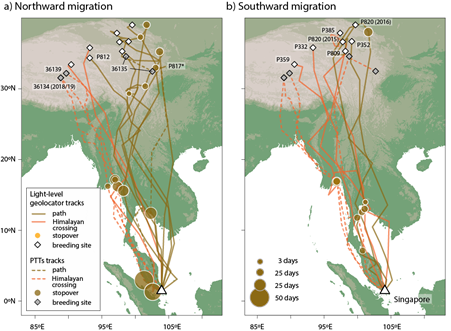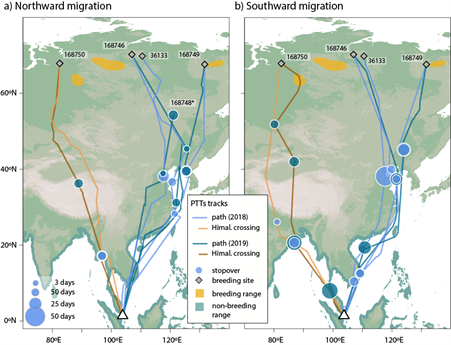- Singapore revealed to be at the intersection of the Central Asian Flyway and East Asian-Australasian Flyway
- These new insights give researchers, policymakers and conservation biologists a more robust understanding of migratory shorebird ecology in Southeast Asia
Researchers at the National Parks Board (NParks) have demonstrated, for the first time, how migratory shorebirds cross the Himalayas from Southeast Asia, in a study published in Nature’s Scientific Reports, on Friday (11 Dec 2020). The study, which spanned five years, also found that Singapore is at the intersection of the East Asian-Australasian Flyway (EAAF) and Central Asian Flyway (CAF).
Titled “Shorebirds wintering in Southeast Asia demonstrate trans-Himalayan flights”, the study involves an international group of researchers from Singapore, Australia, New Zealand, Thailand, China and Germany. Using a suite of bird tracking technology, such as geolocators and satellite tracking devices, researchers analysed key stopover sites of adult Common Redshanks and Whimbrels migrating from wintering grounds in Singapore.
It showed that some adult Common Redshanks (Tringa totanus) and Whimbrels (Numenius phaeopus) wintering in Singapore flew directly over the Himalayas – which extends 2,400km from east to west, with a peak elevation of more than 8,000m – to breeding grounds in the Qinghai-Tibet Plateau in China and north-central Russia via the CAF.
While ringing and observation data showed that shorebirds wintering in South Asia would cross the Himalayas during their migration to its breeding grounds, this is the first time shorebirds wintering in Southeast Asia has been confirmed to do the same. Previously, it was thought that shorebirds wintering in Southeast Asian countries predominantly migrated along the EAAF to avoid the physical barriers of the Himalayan range, where the air is thinner and oxygen levels lower.
The findings also indicate that shorebirds use both the CAF and EAAF to reach their breeding grounds, with Singapore being at the intersection of both flyways. While for years Singapore is known as an important pitstop for migratory shorebirds along the EAAF – with an estimated 2,000 migratory shorebirds of more than 40 different species roosting and feeding at Sungei Buloh Wetland Reserve and Chek Jawa Wetlands in Pulau Ubin every migratory season – it was not known to be in the CAF range.
As such, most conservation initiatives, such as the East Asian-Australasian Flyway Partnership and the ASEAN Flyway Network, currently focus on migratory shorebirds and their habitats along the EAAF. This study illustrates the value of conserving the wetlands habitats, including mangroves, mudflats and freshwater marshes, in Singapore to provide migratory shorebirds using the EAAF or CAF feeding and roosting sites during their stopover here.
These discoveries give researchers a more thorough understanding of shorebird ecology and their migration routes from Southeast Asia. Continued efforts in documenting and learning about their behaviour, breeding patterns and stopovers will allow NParks and the global conservation community to come up with more focused conservation strategies to ensure the long-term survival of these birds.

Figure 1. Migration routes of Common Redshanks based on light-level geolocation in 2015 and 2016, and satellite transmitters in 2018 and 2019. Map Source: ETOPO1 1 Arc-Minute Global Relief Model dataset provided by NOAA https://www.ngdc.noaa.gov/mgg/global/global.html. Produced by Simeon Lisovski.

Figure 2. Migration routes of Whimbrels based on satellite transmitters deployed in Singapore in 2018 and 2019. Map Source: ETOPO1 1 Arc-Minute Global Relief Model dataset provided by NOAA https://www.ngdc.noaa.gov/mgg/global/global.html. Species distribution map provided by BirdLife International. Produced by Simeon Lisovski.
Use of technology
At the Committee of Supply debate this year, plans were announced to transform Singapore into a City in Nature, integrating nature into our city while mitigating the impacts of urbanisation and climate change. Part of this vision includes conserving and restoring Singapore’s natural ecosystems to bolster the island’s resilience against the effects of climate change while safeguarding core habitats of biodiversity to enhance Singapore’s natural capital. This is done through ongoing habitat restoration and species recovery efforts.
Taking reference from the Nature Conservation Masterplan, NParks utilises a science-based approach to ensure that our wetlands are optimal as habitats and when developing effective conservation management plans for native biodiversity and their habitats.
The study used a suite of bird tracking technology, such as geolocators and satellite tracking devices, to track the migratory journeys of 10 adult Common Redshanks and 5 adult Whimbrels between 2015 and 2019.
| Ringing | Bird ringing involves the catching of shorebirds by trained staff using special mist nets set up at strategic locations. A small, uniquely coded metal ring is then attached to the leg of the captured bird for individual for individual identification. Biometrics, such as bill length, wing length, weight and moult stage, are recorded before the bird is released. The subsequent recapture of these ringed birds, which could be in another country, can provide valuable insights, such as about their migration routes and their lifespan.
In this study, data from bird ringing and flag observations was collated and analysed. |
| Geolocators | Geolocator tracking is a cost-effective and established method for shorebird migration study. The device records location data daily, but requires recapturing of the tagged birds to recover the data for processing.
From 2014 to 2016, NParks had employed geolocator tracking technology to track the migratory journeys of 99 Common Redshanks. Ten of these birds were recaptured, and the data of eight adult birds successfully retrieved to provide insights into their rest stops and breeding grounds. |
| Satellite Tracking | In 2017, NParks embarked on the use of higher precision and near real-time satellite tracking devices on migratory shorebirds to gain greater insights to their migration. The solar-powered device fitted on the bird sends signals to the satellites that will relay the locations of the bird to a central database for retrieval. The bird does not need to be recaptured for data processing.
In this study, satellite tracking was analysed on three adult Common Redshanks, one of which was studied with a geolocator as well, and three adult Whimbrels at Sungei Buloh Wetland Reserve, and two adult Whimbrels from Chek Jawa Wetlands. |
Some of the key findings from the geolocators and satellite tracking are below:
- All 10 Common Redshanks were tracked to breeding grounds on the Qinghai-Tibet Plateau in China and mainly bred in the northeastern part of the plateau. During migration, some birds flew through Myanmar in the west, while others flew near the Gulf of Tonkin in Thailand in the east. Three birds then crossed the Himalayan mountain range while the other seven ascended the scarp along the eastern edge of the Qinghai-Tibet Plateau.
- When migrating southwards, the same three birds that crossed the Himalayan mountain range returned via the Himalayas. Three other birds that previously migrated from the east did the same, while the rest travelled south via Yunnan, Laos and Thailand.
- Whimbrels, which breed at much higher latitudes in Russia, showed two very different pathways:
- Of the five birds that were satellite tagged, four migrated along the coasts or over land to the Yellow Sea region through then EAAF, before flying over land to breeding grounds east of Taimyr Peninsula.
- One bird, however, migrated across the Himalayas via the CAF to the Qinghai-Tibet Plateau before flying to the area south of the Yenisei Gulf in Russia, southwest of Taimyr Peninsula. It crossed the Himalayas in both directions of its migration.
- To cross the Himalayas, the tracked Common Redshanks and Whimbrel likely navigated across the mountain passes at around 5,000m to 6,000m above sea level. Being able to cross the Himalayas would reduce the route to their breeding grounds in the Qinghai-Tibet Plateau by 600km. The timings at which the birds migrate from Singapore and leave their stopover sites in Myanmar are critical as it allows them to mitigate against the risk of crossing the Himalayas to breeding grounds that are still frozen.
- Whether a shorebird crosses the Himalayas or uses the EAAF during migration depends largely on their breeding sites. For instance, birds that breed in the west are more likely to cross the Himalayas, allowing them to migrate in a shorter distance.
The full paper can be read at https://www.nature.com/articles/s41598-020-77897-z.




